Zyxel ES3500-8PD User Manual [ru]
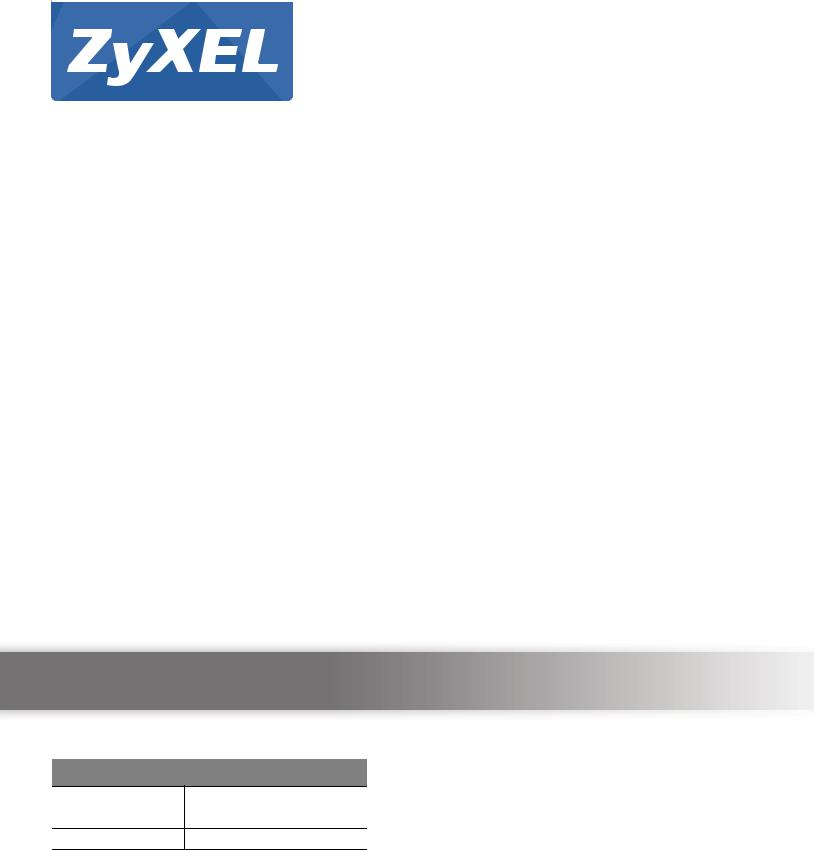
ES3500 Series
Intelligent L2 switch
Version 4.00
Edition 3, 06/2012
Quick Start Guide
User’s Guide
Default Login Details
LAN IP Address |
http://192.168.1.1 |
|
|
User Name |
admin |
Passwordwww.zyxel.com 1234
Copyright © 2012 ZyXEL Communications Corporation

IMPORTANT!
READ CAREFULLY BEFORE USE.
KEEP THIS GUIDE FOR FUTURE REFERENCE.
This is a User’s Guide for a series of products. Not all products support all firmware features. Screenshots and graphics in this book may differ slightly from your product due to differences in your product firmware or your computer operating system. Every effort has been made to ensure that the information in this manual is accurate.
Related Documentation
•CLI Reference Guide
The CLI Reference Guide explains how to use the Command-Line Interface (CLI) to configure the Switch.
Note: It is recommended you use the Web Configurator to configure the Switch.
•Web Configurator Online Help
Click the help icon in any screen for help in configuring that screen and supplementary information.
2 |
|
ES3500 Series User’s Guide |
|
|
|

|
Contents Overview |
|
Contents Overview |
User’s Guide ........................................................................................................................... |
17 |
Getting to Know Your Switch ...................................................................................................... |
19 |
Hardware Installation and Connection ....................................................................................... |
25 |
Hardware Overview .................................................................................................................... |
28 |
The Web Configurator ................................................................................................................ |
37 |
Initial Setup Example ................................................................................................................. |
47 |
Tutorials ..................................................................................................................................... |
52 |
Technical Reference .............................................................................................................. |
77 |
System Status and Port Statistics .............................................................................................. |
79 |
Basic Setting ............................................................................................................................. |
84 |
VLAN .......................................................................................................................................... |
99 |
Static MAC Forward Setup ....................................................................................................... |
116 |
Static Multicast Forward Setup ................................................................................................. |
118 |
Filtering .................................................................................................................................... |
122 |
Spanning Tree Protocol ............................................................................................................ |
124 |
Bandwidth Control .................................................................................................................... |
142 |
Broadcast Storm Control .......................................................................................................... |
145 |
Mirroring ................................................................................................................................... |
147 |
Link Aggregation ...................................................................................................................... |
149 |
Port Authentication ................................................................................................................... |
157 |
Port Security ............................................................................................................................. |
165 |
Classifier .................................................................................................................................. |
167 |
Policy Rule ............................................................................................................................... |
172 |
Queuing Method ....................................................................................................................... |
177 |
VLAN Stacking ......................................................................................................................... |
180 |
Multicast ................................................................................................................................... |
187 |
AAA .......................................................................................................................................... |
202 |
IP Source Guard ...................................................................................................................... |
215 |
Loop Guard .............................................................................................................................. |
234 |
VLAN Mapping ......................................................................................................................... |
238 |
Layer 2 Protocol Tunneling ...................................................................................................... |
242 |
sFlow ........................................................................................................................................ |
246 |
PPPoE ...................................................................................................................................... |
250 |
Error Disable ............................................................................................................................ |
258 |
Private VLAN ............................................................................................................................ |
263 |
Green Ethernet ......................................................................................................................... |
265 |
Static Route .............................................................................................................................. |
267 |
ES3500 Series User’s Guide
3 |

Contents Overview |
|
Differentiated Services ............................................................................................................. |
270 |
DHCP ....................................................................................................................................... |
278 |
Maintenance ............................................................................................................................. |
285 |
Access Control ......................................................................................................................... |
292 |
Diagnostic ................................................................................................................................ |
317 |
Syslog ...................................................................................................................................... |
318 |
Cluster Management ................................................................................................................ |
321 |
MAC Table ................................................................................................................................ |
327 |
ARP Table ................................................................................................................................ |
330 |
Configure Clone ....................................................................................................................... |
332 |
Troubleshooting ....................................................................................................................... |
335 |
4 |
ES3500 Series User’s Guide

|
|
Table of Contents |
|
|
|
|
|
Table of Contents |
Contents Overview .................................................................................................................. |
3 |
|
Table of Contents ..................................................................................................................... |
5 |
|
Part I: User’s Guide ................................................................................ |
17 |
|
Chapter |
1 |
|
Getting to Know Your Switch................................................................................................. |
19 |
|
1.1 |
Introduction .......................................................................................................................... |
19 |
|
1.1.1 Backbone Application ................................................................................................. |
19 |
|
1.1.2 Bridging Example ....................................................................................................... |
20 |
|
1.1.3 High Performance Switching Example ....................................................................... |
20 |
|
1.1.4 IEEE 802.1Q VLAN Application Examples ................................................................. |
21 |
|
1.1.5 IPv6 Support ............................................................................................................... |
22 |
1.2 |
Ways to Manage the Switch ................................................................................................. |
22 |
1.3 |
Good Habits for Managing the Switch .................................................................................. |
23 |
Chapter |
2 |
|
Hardware Installation and Connection ................................................................................. |
25 |
|
2.1 |
Installation Scenarios ........................................................................................................... |
25 |
2.2 |
Desktop Installation Procedure ........................................................................................... |
25 |
2.3 |
Mounting the Switch on a Rack ........................................................................................... |
25 |
|
2.3.1 Rack-mounted Installation Requirements ................................................................... |
26 |
|
2.3.2 Attaching the Mounting Brackets to the Switch .......................................................... |
26 |
|
2.3.3 Mounting the Switch on a Rack .................................................................................. |
27 |
Chapter |
3 |
|
Hardware Overview ................................................................................................................ |
28 |
|
3.1 |
Front and Rear Panels ........................................................................................................ |
28 |
|
3.1.1 Console Port ............................................................................................................... |
30 |
|
3.1.2 Ethernet Ports ............................................................................................................ |
30 |
|
3.1.3 Transceiver Slots ........................................................................................................ |
31 |
|
3.1.4 Power Connector ........................................................................................................ |
33 |
3.2 |
LEDs ................................................................................................................................... |
33 |
Chapter |
4 |
|
The Web Configurator ............................................................................................................ |
37 |
|
4.1 |
Introduction .......................................................................................................................... |
37 |
ES3500 Series User’s Guide
5 |

Table of Contents
4.2 |
System Login .................................................................................................................... |
37 |
4.3 |
The Web Configurator Layout ............................................................................................. |
38 |
|
4.3.1 Change Your Password ........................................................................................... |
43 |
4.4 |
Saving Your Configuration ................................................................................................... |
43 |
4.5 |
Switch Lockout ................................................................................................................... |
43 |
4.6 |
Resetting the Switch ......................................................................................................... |
44 |
|
4.6.1 Reload the Configuration File .................................................................................... |
44 |
4.7 |
Logging Out of the Web Configurator ................................................................................. |
45 |
4.8 |
Help ..................................................................................................................................... |
45 |
Chapter |
5 |
|
Initial Setup Example.............................................................................................................. |
47 |
|
5.1 |
Overview .............................................................................................................................. |
47 |
|
5.1.1 Creating a VLAN ......................................................................................................... |
47 |
|
5.1.2 Setting Port VID .......................................................................................................... |
49 |
5.2 |
Configuring Switch Management IP Address ....................................................................... |
50 |
Chapter |
6 |
|
Tutorials................................................................................................................................... |
|
52 |
6.1 |
How to Use DHCP Snooping on the Switch ......................................................................... |
52 |
6.2 |
How to Use DHCP Relay on the Switch ............................................................................... |
55 |
|
6.2.1 DHCP Relay Tutorial Introduction ............................................................................... |
56 |
|
6.2.2 Creating a VLAN ......................................................................................................... |
56 |
|
6.2.3 Configuring DHCP Relay ............................................................................................ |
58 |
|
6.2.4 Troubleshooting .......................................................................................................... |
59 |
6.3 |
How to Use PPPoE IA on the Switch ................................................................................... |
59 |
|
6.3.1 Configuring Switch A .................................................................................................. |
60 |
|
6.3.2 Configuring Switch B .................................................................................................. |
62 |
6.4 |
How to Use Error Disable and Recovery on the Switch ....................................................... |
65 |
6.5 |
How to Set Up a Guest VLAN .............................................................................................. |
67 |
|
6.5.1 Creating a Guest VLAN .............................................................................................. |
67 |
|
6.5.2 Enabling IEEE 802.1x Port Authentication ................................................................. |
70 |
|
6.5.3 Enabling Guest VLAN ................................................................................................. |
71 |
6.6 |
How to Do Port Isolation in a VLAN ..................................................................................... |
72 |
|
6.6.1 Creating a VLAN ......................................................................................................... |
73 |
|
6.6.2 Creating a Private VLAN Rule .................................................................................... |
75 |
Part II: Technical Reference................................................................... |
77 |
Chapter 7 |
|
System Status and Port Statistics......................................................................................... |
79 |
6 |
ES3500 Series User’s Guide

|
|
Table of Contents |
|
|
|
7.1 |
Overview .............................................................................................................................. |
79 |
7.2 |
Port Status Summary ...................................................................................................... |
79 |
|
7.2.1 Status: Port Details ................................................................................................ |
81 |
Chapter |
8 |
|
Basic Setting .......................................................................................................................... |
84 |
|
8.1 |
Overview .............................................................................................................................. |
84 |
8.2 |
System Information ........................................................................................................... |
84 |
8.3 |
General Setup .................................................................................................................. |
86 |
8.4 |
Introduction to VLANs ......................................................................................................... |
87 |
|
8.4.1 Smart Isolation ............................................................................................................ |
88 |
8.5 |
Switch Setup ..................................................................................................................... |
89 |
8.6 |
IP Setup .............................................................................................................................. |
91 |
|
8.6.1 Management IP Addresses ........................................................................................ |
91 |
8.7 |
Port Setup ........................................................................................................................... |
93 |
8.8 |
PoE ...................................................................................................................................... |
94 |
|
8.8.1 PoE Setup .................................................................................................................. |
96 |
Chapter |
9 |
|
VLAN ........................................................................................................................................ |
|
99 |
9.1 |
Introduction to IEEE 802.1Q Tagged VLANs .................................................................. |
99 |
|
9.1.1 Forwarding Tagged and Untagged Frames ................................................................ |
99 |
9.2 |
Automatic VLAN Registration ............................................................................................ |
100 |
|
9.2.1 GARP ....................................................................................................................... |
100 |
|
9.2.2 GVRP ....................................................................................................................... |
100 |
9.3 |
Port VLAN Trunking .......................................................................................................... |
101 |
9.4 |
Select the VLAN Type ....................................................................................................... |
101 |
9.5 |
Static VLAN ........................................................................................................................ |
101 |
|
9.5.1 VLAN Status ............................................................................................................ |
102 |
|
9.5.2 VLAN Details ............................................................................................................ |
103 |
|
9.5.3 Configure a Static VLAN ....................................................................................... |
104 |
|
9.5.4 Configure VLAN Port Settings .............................................................................. |
105 |
9.6 |
Subnet Based VLANs ....................................................................................................... |
106 |
9.7 |
Configuring Subnet Based VLAN ..................................................................................... |
107 |
9.8 |
Protocol Based VLANs ...................................................................................................... |
109 |
9.9 |
Configuring Protocol Based VLAN ................................................................................... |
110 |
9.10 Create an IP-based VLAN Example ................................................................................. |
111 |
|
9.11 Port-based VLAN Setup ............................................................................................... |
112 |
|
|
9.11.1 Configure a Port-based VLAN ............................................................................... |
112 |
Chapter |
10 |
|
Static MAC Forward Setup................................................................................................... |
116 |
|
10.1 Overview .......................................................................................................................... |
116 |
|
ES3500 Series User’s Guide
7 |

Table of Contents
10.2 Configuring Static MAC Forwarding ............................................................................ |
116 |
Chapter |
11 |
|
|
Static Multicast Forward Setup ........................................................................................... |
118 |
||
11.1 Static Multicast Forwarding Overview .............................................................................. |
118 |
||
11.2 Configuring Static Multicast Forwarding ........................................................................... |
119 |
||
Chapter |
12 |
|
|
Filtering.................................................................................................................................. |
|
|
122 |
12.1 |
Configure a Filtering Rule ............................................................................................... |
122 |
|
Chapter |
13 |
|
|
Spanning Tree Protocol........................................................................................................ |
124 |
||
13.1 |
STP/RSTP Overview ....................................................................................................... |
124 |
|
|
13.1.1 STP Terminology ................................................................................................... |
124 |
|
|
13.1.2 How STP Works .................................................................................................... |
125 |
|
|
13.1.3 STP Port States ..................................................................................................... |
125 |
|
|
13.1.4 Multiple RSTP ........................................................................................................ |
126 |
|
|
13.1.5 Multiple STP ........................................................................................................... |
126 |
|
13.2 |
Spanning Tree Protocol Status Screen ............................................................................ |
129 |
|
13.3 |
Spanning Tree Configuration .......................................................................................... |
129 |
|
13.4 |
Configure Rapid Spanning Tree Protocol ...................................................................... |
130 |
|
13.5 |
Rapid Spanning Tree Protocol Status ........................................................................... |
132 |
|
13.6 |
Configure Multiple Rapid Spanning Tree Protocol ........................................................ |
133 |
|
13.7 |
Multiple Rapid Spanning Tree Protocol Status ........................................................... |
134 |
|
13.8 |
Configure Multiple Spanning Tree Protocol ................................................................... |
136 |
|
|
13.8.1 Multiple Spanning Tree Protocol Port Configuration .............................................. |
139 |
|
13.9 |
Multiple Spanning Tree Protocol Status ..................................................................... |
140 |
|
Chapter |
14 |
|
|
Bandwidth Control................................................................................................................ |
142 |
||
14.1 |
Bandwidth Control Overview ........................................................................................... |
142 |
|
|
14.1.1 CIR and PIR ........................................................................................................... |
142 |
|
14.2 |
Bandwidth Control Setup ................................................................................................. |
143 |
|
Chapter |
15 |
|
|
Broadcast Storm Control ..................................................................................................... |
145 |
||
15.1 |
Broadcast Storm Control Setup ....................................................................................... |
145 |
|
Chapter |
16 |
|
|
Mirroring ................................................................................................................................ |
|
|
147 |
16.1 |
Port Mirroring Setup ........................................................................................................ |
147 |
|
8 |
ES3500 Series User’s Guide

|
|
Table of Contents |
|
|
|
Chapter |
17 |
|
Link Aggregation .................................................................................................................. |
149 |
|
17.1 |
Link Aggregation Overview ............................................................................................. |
149 |
17.2 |
Dynamic Link Aggregation .............................................................................................. |
149 |
|
17.2.1 Link Aggregation ID ............................................................................................... |
150 |
17.3 |
Link Aggregation Status .................................................................................................. |
150 |
17.4 |
Link Aggregation Setting ................................................................................................. |
152 |
17.5 |
Link Aggregation Control Protocol ................................................................................ |
154 |
17.6 |
Static Trunking Example .................................................................................................. |
155 |
Chapter |
18 |
|
Port Authentication .............................................................................................................. |
157 |
|
18.1 |
Port Authentication Overview .......................................................................................... |
157 |
|
18.1.1 IEEE 802.1x Authentication .................................................................................... |
157 |
|
18.1.2 MAC Authentication ................................................................................................ |
158 |
18.2 |
Port Authentication Configuration .................................................................................... |
159 |
|
18.2.1 Activate IEEE 802.1x Security ............................................................................ |
160 |
|
18.2.2 Guest VLAN ........................................................................................................... |
161 |
|
18.2.3 Activate MAC Authentication ................................................................................. |
163 |
Chapter |
19 |
|
Port Security ......................................................................................................................... |
165 |
|
19.1 |
About Port Security .......................................................................................................... |
165 |
19.2 |
Port Security Setup .......................................................................................................... |
165 |
Chapter |
20 |
|
Classifier |
|
167 |
20.1 |
About the Classifier and QoS ........................................................................................... |
167 |
20.2 |
Configuring the Classifier ................................................................................................ |
167 |
20.3 |
Viewing and Editing Classifier Configuration ................................................................... |
169 |
20.4 |
Classifier Example ........................................................................................................... |
171 |
Chapter |
21 |
|
Policy Rule ............................................................................................................................ |
172 |
|
21.1 .................................................................................................... |
Policy Rules Overview |
172 |
................................................................................................................... |
21.1.1 DiffServ |
172 |
................................................................................. |
21.1.2 DSCP and Per - Hop Behavior |
172 |
21.2 .................................................................................................. |
Configuring Policy Rules |
172 |
21.3 ......................................................................... |
Viewing and Editing Policy Configuration |
175 |
21.4 ................................................................................................................. |
Policy Example |
176 |
Chapter |
22 |
|
Queuing Method ................................................................................................................... |
177 |
|
ES3500 Series User’s Guide
9 |

Table of Contents |
|
|
22.1 |
Queuing Method Overview .............................................................................................. |
177 |
22.1.1 Strictly Priority Queuing .......................................................................................... |
177 |
|
22.1.2 Weighted Fair Queuing ........................................................................................... |
177 |
|
22.1.3 Weighted Round Robin Scheduling (WRR) ............................................................ |
178 |
|
22.2 |
Configuring Queuing ........................................................................................................ |
178 |
Chapter 23 |
|
|
VLAN Stacking ...................................................................................................................... |
180 |
|
23.1 |
VLAN Stacking Overview ................................................................................................ |
180 |
23.1.1 VLAN Stacking Example ......................................................................................... |
180 |
|
23.2 |
VLAN Stacking Port Roles ............................................................................................... |
181 |
23.3 |
VLAN Tag Format ............................................................................................................. |
182 |
23.3.1 Frame Format ......................................................................................................... |
182 |
|
23.4 |
Configuring VLAN Stacking .............................................................................................. |
183 |
23.4.1 Port-based Q-in-Q .................................................................................................. |
184 |
|
23.4.2 Selective Q-in-Q .................................................................................................... |
185 |
|
Chapter 24 |
|
|
Multicast ................................................................................................................................ |
|
187 |
24.1 |
Multicast Overview .......................................................................................................... |
187 |
24.1.1 IP Multicast Addresses ........................................................................................... |
187 |
|
24.1.2 IGMP Filtering ......................................................................................................... |
187 |
|
24.1.3 IGMP Snooping ..................................................................................................... |
187 |
|
24.1.4 IGMP Snooping and VLANs ................................................................................... |
188 |
|
24.2 |
Multicast Status ............................................................................................................... |
188 |
24.3 |
Multicast Setting .............................................................................................................. |
189 |
24.4 IGMP Snooping VLAN .................................................................................................... |
192 |
|
24.5 |
IGMP Filtering Profile ...................................................................................................... |
193 |
24.6 MVR Overview ................................................................................................................ |
194 |
|
24.6.1 Types of MVR Ports ................................................................................................ |
195 |
|
24.6.2 MVR Modes ............................................................................................................ |
195 |
|
24.6.3 How MVR Works .................................................................................................... |
195 |
|
24.7 |
General MVR Configuration ............................................................................................. |
196 |
24.8 |
MVR Group Configuration ............................................................................................... |
198 |
24.8.1 MVR Configuration Example .................................................................................. |
199 |
|
Chapter 25 |
|
|
AAA ........................................................................................................................................ |
|
202 |
25.1 |
Authentication, Authorization and Accounting (AAA) ....................................................... |
202 |
25.1.1 Local User Accounts ............................................................................................... |
202 |
|
25.1.2 RADIUS and TACACS+ ......................................................................................... |
203 |
|
25.2 |
AAA Screens .................................................................................................................... |
203 |
25.2.1 RADIUS Server Setup ........................................................................................... |
203 |
|
10 |
ES3500 Series User’s Guide

|
|
Table of Contents |
25.2.2 TACACS+ Server Setup ..................................................................................... |
206 |
|
25.2.3 AAA Setup .............................................................................................................. |
208 |
|
25.2.4 Vendor Specific Attribute ........................................................................................ |
210 |
|
25.2.5 Tunnel Protocol Attribute ........................................................................................ |
211 |
|
25.3 |
Supported RADIUS Attributes .......................................................................................... |
211 |
25.3.1 Attributes Used for Authentication .......................................................................... |
212 |
|
25.3.2 Attributes Used for Accounting ............................................................................... |
212 |
|
Chapter 26 |
|
|
IP Source Guard.................................................................................................................... |
215 |
|
26.1 |
IP Source Guard Overview .............................................................................................. |
215 |
26.1.1 DHCP Snooping Overview ..................................................................................... |
215 |
|
26.1.2 ARP Inspection Overview ....................................................................................... |
217 |
|
26.2 |
IP Source Guard .............................................................................................................. |
219 |
26.3 |
IP Source Guard Static Binding ........................................................................................ |
219 |
26.4 DHCP Snooping ............................................................................................................... |
221 |
|
26.5 |
DHCP Snooping Configure .............................................................................................. |
223 |
26.5.1 DHCP Snooping Port Configure ............................................................................. |
225 |
|
26.5.2 DHCP Snooping VLAN Configure .......................................................................... |
226 |
|
26.6 |
ARP Inspection Status ..................................................................................................... |
227 |
26.6.1 ARP Inspection VLAN Status ................................................................................. |
228 |
|
26.6.2 ARP Inspection Log Status ..................................................................................... |
229 |
|
26.7 |
ARP Inspection Configure ................................................................................................ |
230 |
26.7.1 ARP Inspection Port Configure ............................................................................... |
231 |
|
26.7.2 ARP Inspection VLAN Configure ............................................................................ |
233 |
|
Chapter 27 |
|
|
Loop Guard ........................................................................................................................... |
234 |
|
27.1 |
Loop Guard Overview ..................................................................................................... |
234 |
27.2 |
Loop Guard Setup ............................................................................................................ |
236 |
Chapter 28 |
|
|
VLAN Mapping ...................................................................................................................... |
238 |
|
28.1 |
VLAN Mapping Overview ................................................................................................ |
238 |
28.1.1 VLAN Mapping Example ........................................................................................ |
238 |
|
28.2 |
Enabling VLAN Mapping .................................................................................................. |
239 |
28.3 |
Configuring VLAN Mapping .............................................................................................. |
240 |
Chapter 29 |
|
|
Layer 2 Protocol Tunneling.................................................................................................. |
242 |
|
29.1 |
Layer 2 Protocol Tunneling Overview ............................................................................. |
242 |
29.1.1 Layer-2 Protocol Tunneling Mode ........................................................................... |
243 |
|
29.2 |
Configuring Layer 2 Protocol Tunneling ........................................................................... |
244 |
ES3500 Series User’s Guide
11 |

Table of Contents
Chapter |
30 |
|
|
sFlow...................................................................................................................................... |
|
|
246 |
30.1 sFlow Overview ................................................................................................................ |
246 |
||
30.2 sFlow Port Configuration .................................................................................................. |
247 |
||
|
30.2.1 sFlow Collector Configuration ................................................................................. |
248 |
|
Chapter |
31 |
|
|
PPPoE .................................................................................................................................... |
|
|
250 |
31.1 |
PPPoE Intermediate Agent Overview ............................................................................. |
250 |
|
|
31.1.1 PPPoE Intermediate Agent Tag Format ................................................................. |
250 |
|
|
31.1.2 Sub-Option Format ................................................................................................. |
250 |
|
|
31.1.3 Port State ................................................................................................................ |
251 |
|
31.2 The PPPoE Screen .......................................................................................................... |
252 |
||
31.3 |
PPPoE Intermediate Agent ............................................................................................. |
252 |
|
|
31.3.1 PPPoE IA Per-Port ................................................................................................ |
254 |
|
|
31.3.2 PPPoE IA Per-Port Per-VLAN ............................................................................... |
255 |
|
|
31.3.3 PPPoE IA for VLAN ............................................................................................... |
257 |
|
Chapter |
32 |
|
|
Error Disable ......................................................................................................................... |
258 |
||
32.1 |
CPU Protection Overview ................................................................................................ |
258 |
|
32.2 |
Error-Disable Recovery Overview .................................................................................... |
258 |
|
32.3 |
The Error Disable Screen ................................................................................................. |
259 |
|
32.4 |
CPU Protection Configuration ......................................................................................... |
259 |
|
32.5 |
Error-Disable Detect Configuration ................................................................................. |
260 |
|
32.6 |
Error-Disable Recovery Configuration ............................................................................ |
261 |
|
Chapter |
33 |
|
|
Private VLAN ......................................................................................................................... |
263 |
||
33.1 |
Private VLAN Overview ................................................................................................... |
263 |
|
33.2 |
Configuring Private VLAN ................................................................................................ |
264 |
|
Chapter |
34 |
|
|
Green Ethernet...................................................................................................................... |
265 |
||
34.1 |
Green Ethernet Overview ................................................................................................ |
265 |
|
34.2 |
Configuring Green Ethernet ............................................................................................. |
266 |
|
Chapter |
35 |
|
|
Static Route ........................................................................................................................... |
267 |
||
35.1 |
Static Routing Overview ................................................................................................... |
267 |
|
35.2 |
Configuring Static Routing ................................................................................................ |
268 |
|
12 |
ES3500 Series User’s Guide

|
|
Table of Contents |
Chapter 36 |
|
|
Differentiated Services......................................................................................................... |
270 |
|
36.1 |
DiffServ Overview ........................................................................................................... |
270 |
36.1.1 DSCP and Per-Hop Behavior ................................................................................. |
270 |
|
36.1.2 DiffServ Network Example ..................................................................................... |
270 |
|
36.2 |
Two Rate Three Color Marker Traffic Policing ................................................................. |
271 |
36.2.1 TRTCM-Color-blind Mode ....................................................................................... |
272 |
|
36.2.2 TRTCM-Color-aware Mode .................................................................................... |
272 |
|
36.3 |
Activating DiffServ ............................................................................................................ |
272 |
36.3.1 Configuring 2-Rate 3 Color Marker Settings .......................................................... |
273 |
|
36.3.2 Configuring DSCP Profiles .................................................................................... |
275 |
|
36.4 |
DSCP-to-IEEE 802.1p Priority Settings ......................................................................... |
276 |
36.4.1 Configuring DSCP Settings .................................................................................... |
276 |
|
Chapter 37 |
|
|
DHCP...................................................................................................................................... |
|
278 |
37.1 DHCP Overview .............................................................................................................. |
278 |
|
37.1.1 DHCP Modes ......................................................................................................... |
278 |
|
37.1.2 DHCP Configuration Options .................................................................................. |
278 |
|
37.2 |
DHCP Status .................................................................................................................... |
278 |
37.3 DHCP Relay .................................................................................................................... |
279 |
|
37.3.1 DHCP Relay Agent Information .............................................................................. |
279 |
|
37.3.2 Configuring DHCP Global Relay ............................................................................ |
280 |
|
37.3.3 Global DHCP Relay Configuration Example .......................................................... |
281 |
|
37.4 |
Configuring DHCP VLAN Settings ................................................................................ |
282 |
37.4.1 Example: DHCP Relay for Two VLANs .................................................................. |
283 |
|
Chapter 38 |
|
|
Maintenance .......................................................................................................................... |
285 |
|
38.1 |
The Maintenance Screen ................................................................................................ |
285 |
38.2 |
Load Factory Default ....................................................................................................... |
286 |
38.3 |
Save Configuration ........................................................................................................... |
286 |
38.4 |
Reboot System ................................................................................................................. |
286 |
38.5 |
Firmware Upgrade ........................................................................................................... |
287 |
38.6 |
Restore a Configuration File ............................................................................................ |
288 |
38.7 |
Backup a Configuration File ............................................................................................. |
288 |
38.8 FTP Command Line ......................................................................................................... |
289 |
|
38.8.1 Filename Conventions ........................................................................................... |
289 |
|
38.8.2 FTP Command Line Procedure .............................................................................. |
290 |
|
38.8.3 GUI-based FTP Clients ........................................................................................... |
290 |
|
38.8.4 FTP Restrictions .................................................................................................... |
290 |
|
ES3500 Series User’s Guide
13 |

Table of Contents
Chapter |
39 |
|
|
Access Control ..................................................................................................................... |
292 |
||
39.1 |
Access Control Overview ............................................................................................. |
292 |
|
39.2 |
The Access Control Main Screen ..................................................................................... |
292 |
|
39.3 About SNMP ................................................................................................................... |
292 |
||
|
39.3.1 SNMP v3 and Security ........................................................................................... |
293 |
|
|
39.3.2 Supported MIBs ..................................................................................................... |
294 |
|
|
39.3.3 SNMP Traps ........................................................................................................... |
294 |
|
|
39.3.4 Configuring SNMP ................................................................................................. |
301 |
|
|
39.3.5 Configuring SNMP Trap Group ............................................................................ |
302 |
|
|
39.3.6 Configuring SNMP User ...................................................................................... |
303 |
|
39.4 |
Setting Up Login Accounts ........................................................................................... |
305 |
|
39.5 |
SSH Overview .................................................................................................................. |
306 |
|
39.6 How SSH works ............................................................................................................... |
307 |
||
39.7 |
SSH Implementation on the Switch .................................................................................. |
308 |
|
|
39.7.1 Requirements for Using SSH .................................................................................. |
308 |
|
39.8 |
Introduction to HTTPS ...................................................................................................... |
308 |
|
39.9 HTTPS Example .............................................................................................................. |
309 |
||
|
39.9.1 Internet Explorer Warning Messages ..................................................................... |
309 |
|
|
39.9.2 Mozilla Firefox Warning Messages ......................................................................... |
312 |
|
|
39.9.3 The Main Screen .................................................................................................... |
313 |
|
39.10 Service Port Access Control ....................................................................................... |
314 |
||
39.11 Remote Management ................................................................................................ |
315 |
||
Chapter |
40 |
|
|
Diagnostic |
............................................................................................................................. |
317 |
|
40.1 |
Diagnostic ....................................................................................................................... |
317 |
|
Chapter |
41 |
|
|
Syslog .................................................................................................................................... |
|
|
318 |
41.1 |
Syslog Overview .............................................................................................................. |
318 |
|
41.2 |
Syslog Setup ................................................................................................................... |
319 |
|
41.3 |
Syslog Server Setup ....................................................................................................... |
320 |
|
Chapter |
42 |
|
|
Cluster Management ............................................................................................................ |
321 |
||
42.1 |
Cluster Management Status Overview ............................................................................ |
321 |
|
42.2 |
Cluster Management Status ............................................................................................ |
322 |
|
|
42.2.1 Cluster Member Switch Management ................................................................... |
323 |
|
42.3 |
Clustering Management Configuration ............................................................................ |
325 |
|
Chapter |
43 |
|
|
MAC Table |
............................................................................................................................. |
327 |
|
14 |
ES3500 Series User’s Guide

|
|
|
Table of Contents |
|
|
|
|
43.1 |
MAC Table Overview ....................................................................................................... |
327 |
|
43.2 |
Viewing the MAC Table ................................................................................................... |
328 |
|
Chapter |
44 |
|
|
ARP Table |
.............................................................................................................................. |
330 |
|
44.1 |
ARP Table Overview ....................................................................................................... |
330 |
|
|
44.1.1 How ARP Works ..................................................................................................... |
330 |
|
44.2 .................................................................................................... |
The ARP Table Screen |
331 |
|
Chapter |
45 |
|
|
Configure Clone.................................................................................................................... |
332 |
||
45.1 .............................................................................................................. |
Configure Clone |
332 |
|
Chapter |
46 |
|
|
Troubleshooting.................................................................................................................... |
335 |
||
46.1 ....................................................................... |
Power, Hardware Connections, and LEDs |
335 |
|
46.2 ................................................................................................. |
Switch Access and Login |
337 |
|
46.3 ........................................................................................................ |
Switch Configuration |
339 |
|
Appendix |
A ............................................................................................Common Services |
341 |
|
Appendix |
B ..............................................................................................Legal Information |
345 |
|
Safety Warnings.................................................................................................................... |
348 |
||
Index ...................................................................................................................................... |
|
|
351 |
ES3500 Series User’s Guide
15 |

Table of Contents
16 |
ES3500 Series User’s Guide

PART I
User’s Guide
17

18

1
Getting to Know Your Switch
This chapter introduces the main features and applications of the Switch.
1.1 Introduction
The Switch is a layer-2 standalone Ethernet switch. There are three models of the Switch.
Table 1 Switch models and features
MODEL |
DISTINGUISHING FEATURES |
ES3500-24 |
24 10/100 Ethernet ports |
|
4 dual-personality interfaces - 10/100/1000 Mbps Ethernet or 1000 Mbps |
|
Fiber. |
|
|
ES3500-24HP |
24 10/100 Ethernet ports: only these can supply PoE. |
|
4 dual personality interfaces: 10/100/1000 Mbps Ethernet or 100/1000 |
|
Mbps Fiber. |
|
|
ES3500-8PD |
8 10/100 Ethernet ports. |
|
2 dual personality interfaces: 10/100/1000 Mbps Ethernet or 100/1000 |
|
Mbps Fiber. |
|
Only port 9 can receive power from a PoE switch |
|
All 10 ports support Green Ethernet to reduce switch port power |
|
consumption. |
|
|
Dual-personality interfaces comprise one RJ-45 port and one mini-GBIC slot, with either a port or a slot active at a time.
With its built-in web configurator, managing and configuring the Switch is easy. In addition, the Switch can also be managed via Telnet, any terminal emulator program on the console port, or third-party SNMP management.
This section shows a few examples of using the Switch in various network environments.
1.1.1 Backbone Application
The Switch is an ideal solution for small networks where rapid growth can be expected in the near future. The Switch can be used standalone for a group of heavy traffic users. You can connect computers and servers directly to the Switch’s port or connect other switches to the Switch.
ES3500 Series User’s Guide
19 |
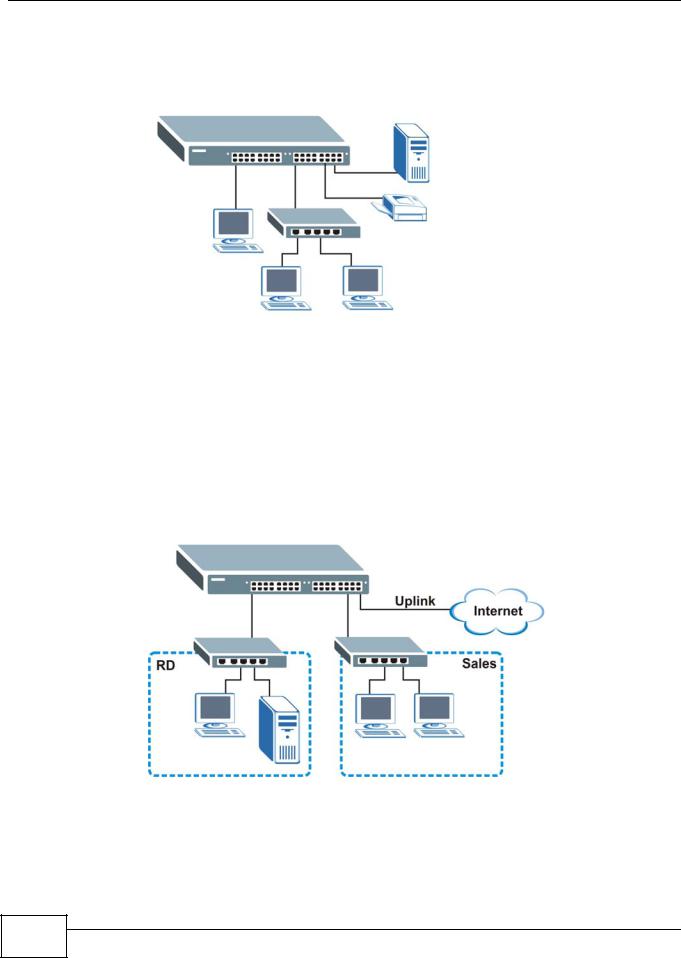
Chapter 1 Getting to Know Your Switch
In this example, all computers can share high-speed applications on the server. To expand the network, simply add more networking devices such as switches, routers, computers, print servers etc.
Figure 1 Backbone Application
1.1.2 Bridging Example
In this example, the Switch connects different company departments (RD and Sales) to the corporate backbone. It can alleviate bandwidth contention and eliminate server and network bottlenecks. All users that need high bandwidth can connect to high-speed department servers via the Switch. You can provide a super-fast uplink connection by using a Gigabit Ethernet/mini-GBIC port on the Switch.
Moreover, the Switch eases supervision and maintenance by allowing network managers to centralize multiple servers at a single location.
Figure 2 Bridging Application
1.1.3 High Performance Switching Example
The Switch is ideal for connecting two networks that need high bandwidth. In the following example, use trunking to connect these two networks.
20 |
ES3500 Series User’s Guide
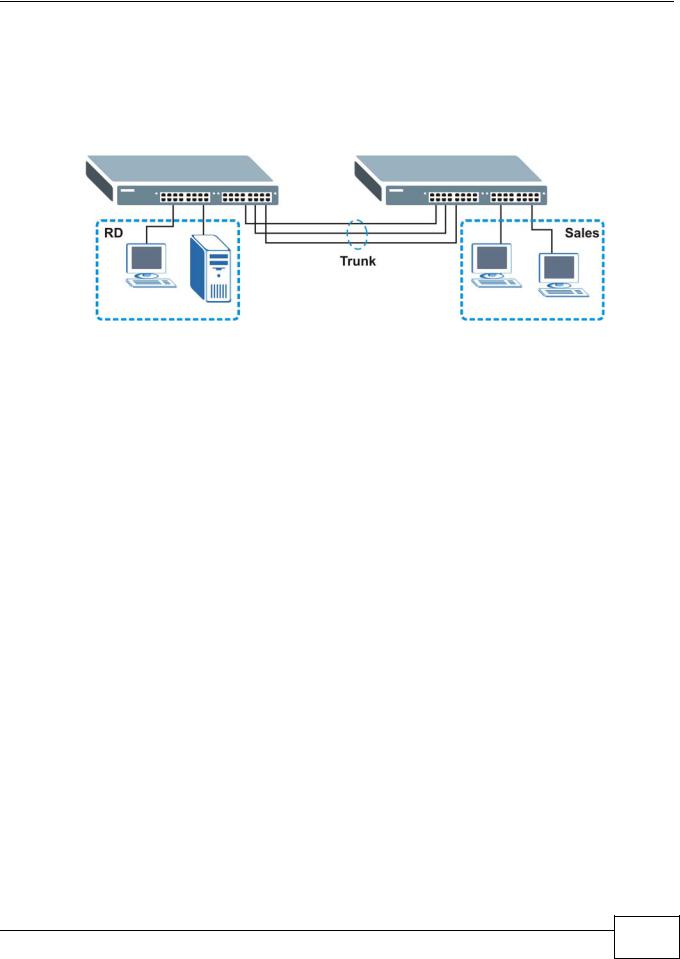
Chapter 1 Getting to Know Your Switch
Switching to higher-speed LANs such as ATM (Asynchronous Transmission Mode) is not feasible for most people due to the expense of replacing all existing Ethernet cables and adapter cards, restructuring your network and complex maintenance. The Switch can provide the same bandwidth as ATM at much lower cost while still being able to use existing adapters and switches. Moreover, the current LAN structure can be retained as all ports can freely communicate with each other.
Figure 3 High Performance Switched Workgroup Application
1.1.4 IEEE 802.1Q VLAN Application Examples
A VLAN (Virtual Local Area Network) allows a physical network to be partitioned into multiple logical networks. Stations on a logical network belong to one group. A station can belong to more than one group. With VLAN, a station cannot directly talk to or hear from stations that are not in the same group(s) unless such traffic first goes through a router.
For more information on VLANs, refer to Chapter 9 on page 99.
1.1.4.1 Tag-based VLAN Example
Ports in the same VLAN group share the same frame broadcast domain thus increase network performance through reduced broadcast traffic. VLAN groups can be modified at any time by adding, moving or changing ports without any re-cabling.
ES3500 Series User’s Guide
21 |
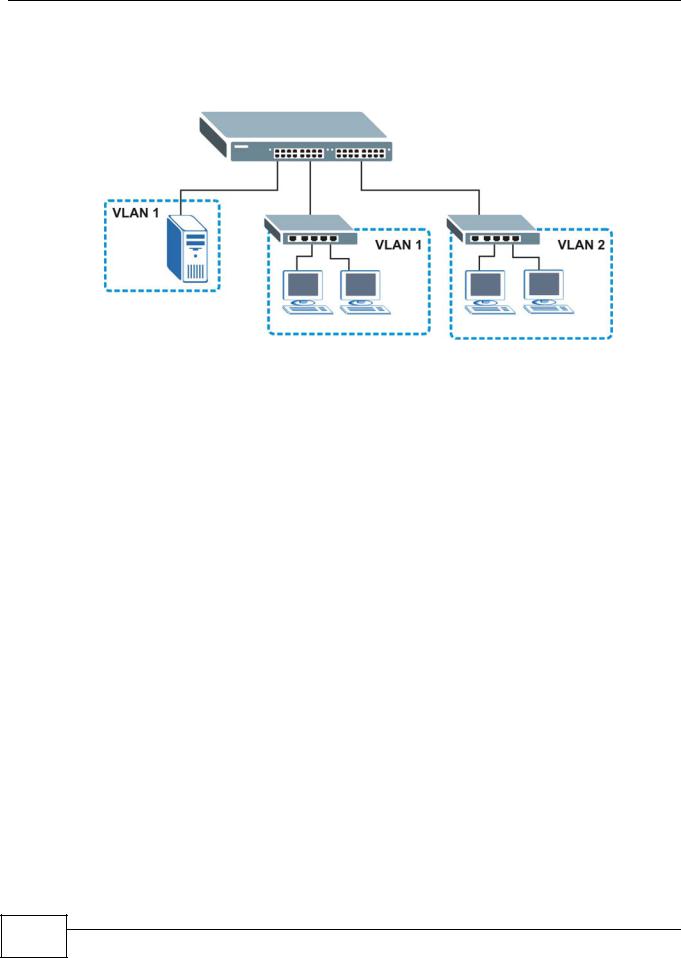
Chapter 1 Getting to Know Your Switch
Shared resources such as a server can be used by all ports in the same VLAN as the server. In the following figure only ports that need access to the server need to be part of VLAN 1. Ports can belong to other VLAN groups too.
Figure 4 Shared Server Using VLAN Example
1.1.5 IPv6 Support
IPv6 (Internet Protocol version 6), is designed to enhance IP address size and features. The increase in IPv6 address size to 128 bits (from the 32-bit IPv4 address) allows up to 3.4 x 1038 IP addresses. At the time of writing, the Switch supports the following features.
•Static address assignment and stateless auto-configuration
•Neighbor Discovery Protocol (a protocol used to discover other IPv6 devices in a network)
•Remote Management using ping SNMP, telnet, HTTP and FTP services
•ICMPv6 to report errors encountered in packet processing and perform diagnostic functions, such as "ping”
•IPv4/IPv6 dual stack; the Switch can run IPv4 and IPv6 at the same time
•DHCPv6 client and relay
•Multicast Listener Discovery (MLD) snooping and proxy
For more information on IPv6, refer to the CLI Reference Guide.
1.2 Ways to Manage the Switch
Use any of the following methods to manage the Switch.
•Web Configurator. This is recommended for everyday management of the Switch using a (supported) web browser. See Chapter 4 on page 37.
•Command Line Interface. Line commands offer an alternative to the web configurator and in some cases are necessary to configure advanced features. See the CLI Reference Guide.
•FTP. Use FTP for firmware upgrades and configuration backup/restore. See Section 38.8 on page 289.
•SNMP. The Switch can be monitored by an SNMP manager. See Section 39.3 on page 292.
22 |
ES3500 Series User’s Guide

Chapter 1 Getting to Know Your Switch
•Cluster Management. Cluster Management allows you to manage multiple switches through one switch, called the cluster manager. See Chapter 42 on page 321.
1.3Good Habits for Managing the Switch
Do the following things regularly to make the Switch more secure and to manage the Switch more effectively.
•Change the password. Use a password that’s not easy to guess and that consists of different types of characters, such as numbers and letters.
•Write down the password and put it in a safe place.
•Back up the configuration (and make sure you know how to restore it). Restoring an earlier working configuration may be useful if the device becomes unstable or even crashes. If you forget your password, you will have to reset the Switch to its factory default settings. If you backed up an earlier configuration file, you would not have to totally re-configure the Switch. You could simply restore your last configuration.
ES3500 Series User’s Guide
23 |

Chapter 1 Getting to Know Your Switch
24 |
ES3500 Series User’s Guide

2
Hardware Installation and Connection
This chapter shows you how to install and connect the Switch.
2.1 Installation Scenarios
The Switch can be placed on a desktop or rack-mounted on a standard EIA rack. Use the rubber feet in a desktop installation and the brackets in a rack-mounted installation. The following table shows how each model can be mounted.
Table 2 Installation Scenarios
MODEL |
MOUNTING TYPE |
ES3500-24 |
19” rack-mounted |
|
|
ES3500-24HP |
19” rack-mounted |
|
|
ES3500-8PD |
Desktop (rack-mountable) |
|
|
Note: For proper ventilation, allow at least 4 inches (10 cm) of clearance at the front and 3.4 inches (8 cm) at the back of the Switch. This is especially important for enclosed rack installations.
2.2 Desktop Installation Procedure
1Make sure the Switch is clean and dry.
2Set the Switch on a smooth, level surface strong enough to support the weight of the Switch and the connected cables. Make sure there is a power outlet nearby.
3Make sure there is enough clearance around the Switch to allow air circulation and the attachment of cables and the power cord.
2.3Mounting the Switch on a Rack
The Switch can be mounted on an EIA standard size, 19-inch rack or in a wiring closet with other equipment. Follow the steps below to mount your Switch on a standard EIA rack using a rackmounting kit.
ES3500 Series User’s Guide
25 |

Chapter 2 Hardware Installation and Connection
2.3.1Rack-mounted Installation Requirements
•Two mounting brackets.
•Eight M3 flat head screws and a #2 Philips screwdriver.
•Four M5 flat head screws and a #2 Philips screwdriver.
Failure to use the proper screws may damage the unit.
2.3.1.1Precautions
•Make sure the rack will safely support the combined weight of all the equipment it contains.
•Make sure the position of the Switch does not make the rack unstable or top-heavy. Take all necessary precautions to anchor the rack securely before installing the unit.
2.3.2Attaching the Mounting Brackets to the Switch
1Position a mounting bracket on one side of the Switch, lining up the four screw holes on the bracket with the screw holes on the side of the Switch.
Figure 5 Attaching the Mounting Brackets (non-desktop models)
Figure 6 Attaching the Mounting Brackets (desktop models)
2Using a #2 Philips screwdriver, install the M3 flat head screws through the mounting bracket holes into the Switch.
3Repeat steps 1 and 2 to install the second mounting bracket on the other side of the Switch.
4You may now mount the Switch on a rack. Proceed to the next section.
26 |
ES3500 Series User’s Guide
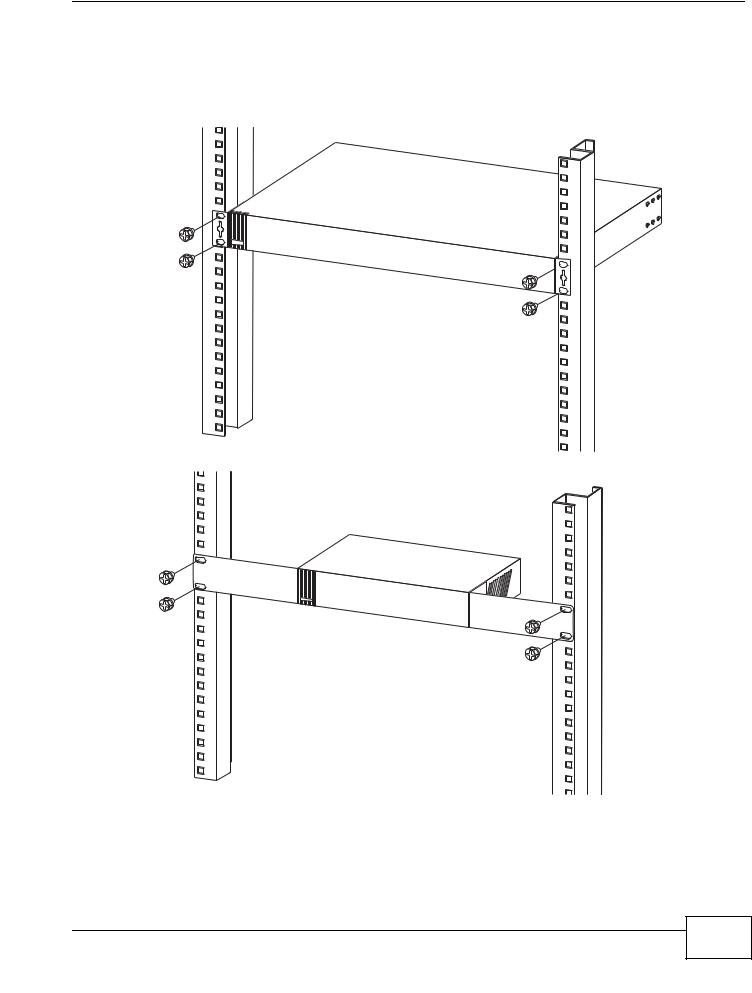
Chapter 2 Hardware Installation and Connection
2.3.3Mounting the Switch on a Rack
1Position a mounting bracket (that is already attached to the Switch) on one side of the rack, lining up the two screw holes on the bracket with the screw holes on the side of the rack.
Figure 7 Mounting the Switch on a Rack (non-desktop models)
Figure 8 Mounting the Switch on a Rack (desktop models)
2Using a #2 Philips screwdriver, install the M5 flat head screws through the mounting bracket holes into the rack.
3Repeat steps 1 and 2 to attach the second mounting bracket on the other side of the rack.
ES3500 Series User’s Guide
27 |
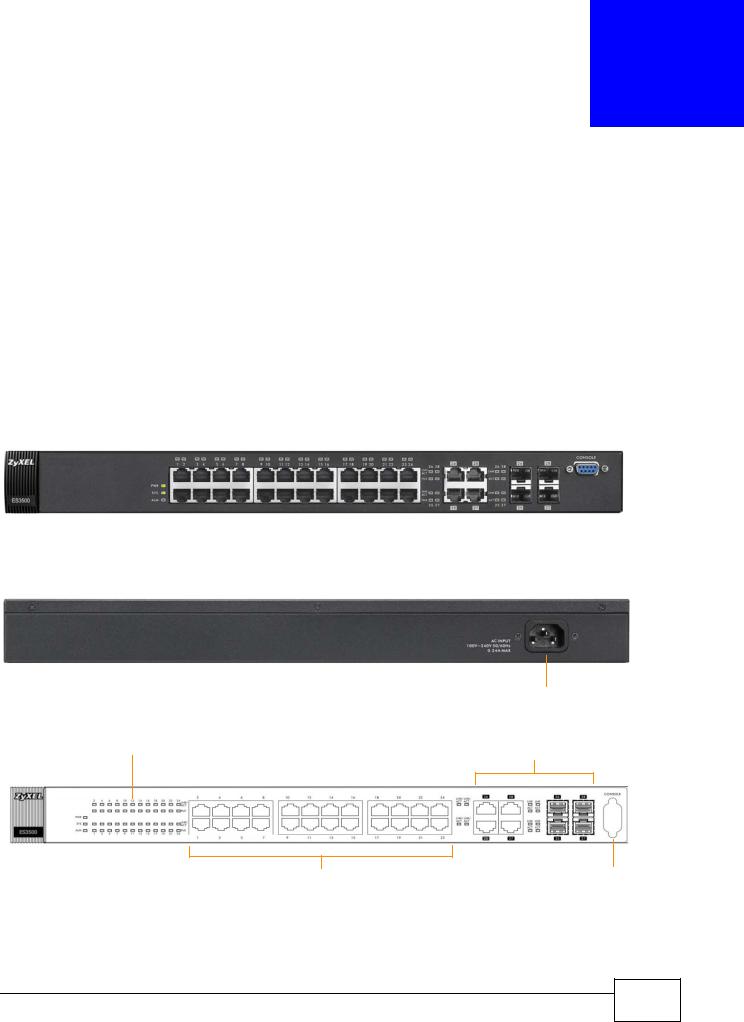
3
Hardware Overview
This chapter describes the front panel and rear panel of the Switch and shows you how to make the hardware connections.
3.1 Front and Rear Panels
The following figures show the front and rear panels of the Switch.
Figure 9 ES3500-24 Front Panel
LEDs |
Dual-personality Interfaces |
|||||||
|
|
|
|
|
|
|
|
|
|
|
|
|
|
|
|
|
|
|
|
|
|
|
|
|
|
|
|
|
|
|
|
|
|
|
|
|
|
|
|
|
|
|
|
|
|
|
|
|
|
|
|
|
|
|
|
|
|
|
|
|
|
|
|
|
|
|
|
|
|
|
|
Ethernet Ports |
Console Port |
Figure 10 ES3500-24 Rear Panel
AC Power Connection
Figure 11 ES3500-24HP Front Panel
LEDs |
Dual-personality Interfaces |
|
Ethernet Ports |
Console Port |
ES3500 Series User’s Guide
28 |
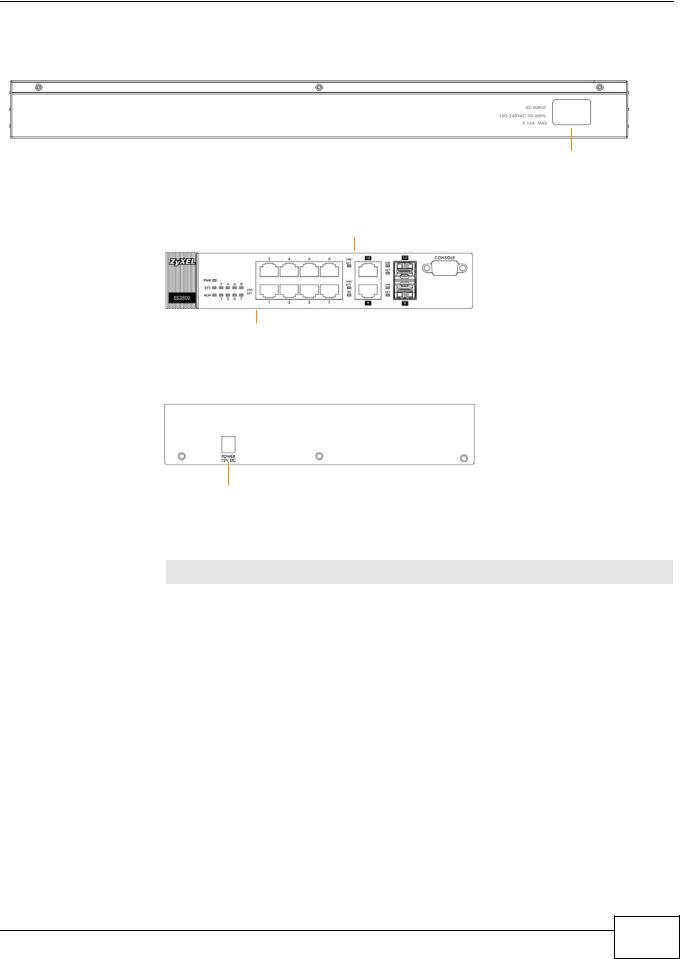
Chapter 3 Hardware Overview
Figure 12 ES3500-24HP Rear Panel
AC Power Connection
Figure 13 ES3500-8PD Front Panel
LEDs |
|
Dual-personality Interfaces |
|||||||
|
|
|
|
|
|
|
|
|
|
|
|
|
|
|
|
|
|
|
|
|
|
|
|
|
|
|
|
|
|
|
|
|
|
|
|
|
|
|
|
|
|
|
|
|
|
|
|
|
|
|
|
|
|
|
|
|
|
|
|
Ethernet Ports PoE In |
Console Port |
Figure 14 ES3500-8PD Rear Panel
DC Power Connection
The following table describes the connectors on the front and rear panels.
Table 3 Front and Rear Panel Connections
LABEL |
DESCRIPTION |
|
10/100 Mbps |
Connect these ports to a computer, a hub, an Ethernet switch or router. |
|
RJ-45 Ethernet |
|
|
Ports |
|
|
|
|
|
Dual- |
Each dual-personality interface has one RJ-45 port and one Small Form-Factor Pluggable |
|
Personality |
(SFP) slot (also called a mini-GBIC slot), with one port or transceiver active at a time. |
|
Interfaces |
• |
RJ-45 Ports: |
|
||
|
|
Connect these ports to high-bandwidth backbone network Ethernet switches using |
|
|
Category 5/5e/6 copper cables. |
|
• |
SFP Slots: |
|
|
Use SFP transceivers in these slots for connections to backbone Ethernet switches. |
|
|
|
Console Port |
The console port is for local configuration of the Switch. |
|
|
|
|
AC Power |
Connect an appropriate power supply to this port. |
|
Connection |
|
|
|
|
|
DC Power |
Connect an appropriate power supply to this port. |
|
Connection |
|
|
|
|
|
ES3500 Series User’s Guide
29 |

Chapter 3 Hardware Overview
3.1.1 Console Port
For local management, you can use a computer with terminal emulation software configured to the following parameters:
•VT100
•Terminal emulation
•9600 bps
•No parity, 8 data bits, 1 stop bit
•No flow control
Connect the male 9-pin end of the console cable to the console port of the Switch. Connect the female end to a serial port (COM1, COM2 or other COM port) of your computer.
3.1.2 Ethernet Ports
The Switch has 10/100 Mbps auto-negotiating, auto-crossover Ethernet ports. In 10/100 Mbps Fast Ethernet, the speed can be 10 Mbps or 100 Mbps and the duplex mode can be half duplex or full duplex.
An auto-negotiating port can detect and adjust to the optimum Ethernet speed (10/100 Mbps) and duplex mode (full duplex or half duplex) of the connected device.
An auto-crossover (auto-MDI/MDI-X) port automatically works with a straight-through or crossover Ethernet cable.
The Switch has several dual-personality interfaces, (see Figure 9 on page 28 and Figure 13 on page 29), each of which consists of an RJ-45 Ethernet port and SFP slot pair. The Switch activates one connection of each RJ-45 and SFP slot pair. The SFP slots have priority over the RJ-45 ports. This means that if an RJ-45 port and the corresponding SFP slot are connected at the same time, the RJ45 port will be disabled.
When auto-negotiation is turned on, a Ethernet port negotiates with the peer automatically to determine the connection speed and duplex mode. If the peer Ethernet port does not support autonegotiation or turns off this feature, the Switch determines the connection speed by detecting the signal on the cable and using half duplex mode. When the Switch’s auto-negotiation is turned off, an Ethernet port uses the pre-configured speed and duplex mode when making a connection, thus requiring you to make sure that the settings of the peer Ethernet port are the same in order to connect.
3.1.2.1 Default Ethernet Negotiation Settings
The factory default negotiation settings for the Gigabit ports on the Switch are:
•Speed: Auto
•Duplex: Auto
•Flow control: Off
•Link Aggregation: Disabled
30 |
ES3500 Series User’s Guide
